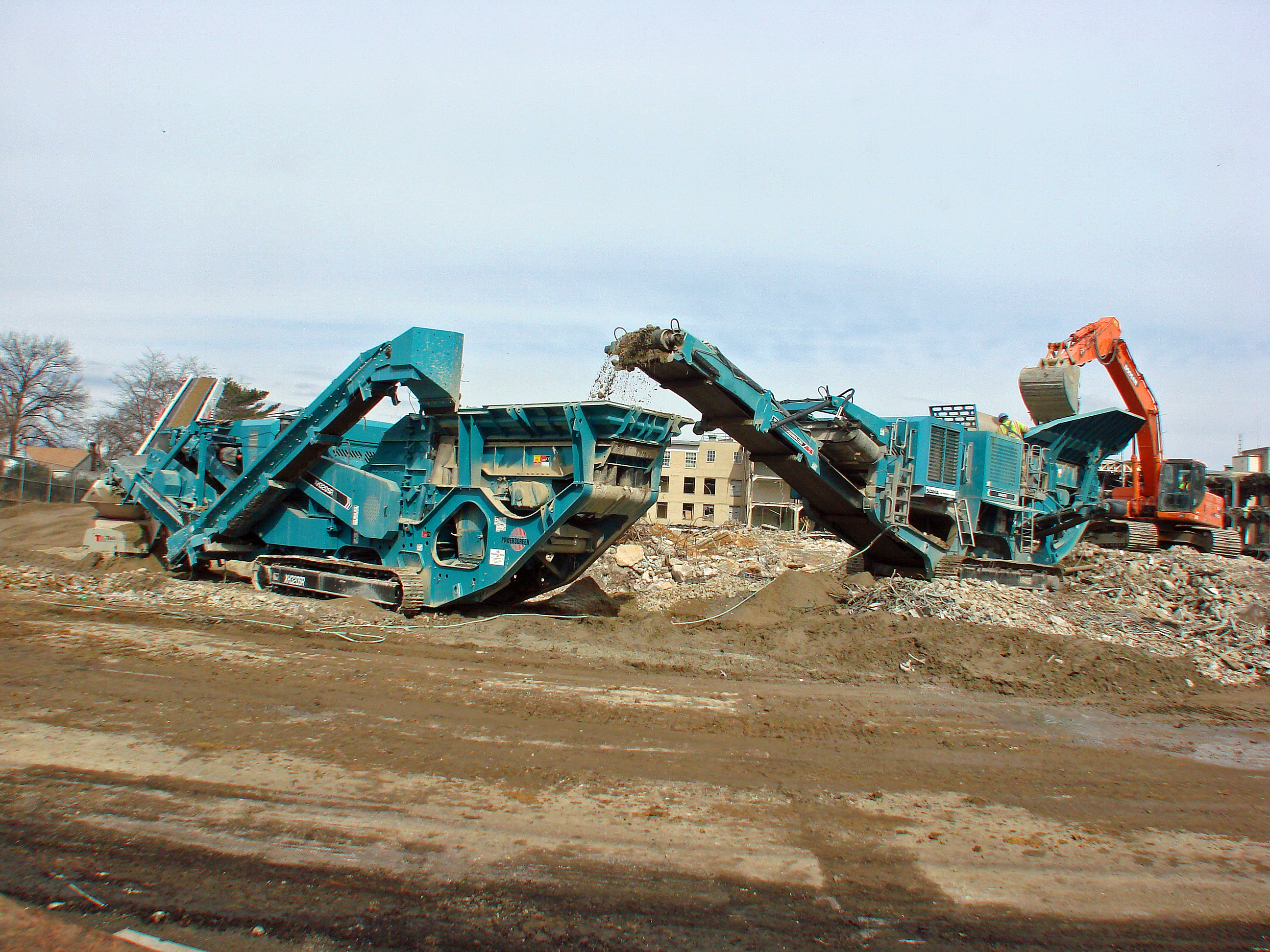
Demolition Services (DSI) and
The 42 acre (17 hectare) site was built in 1941 as a temporary warehouse but was converted to federal office use after Pearl Harbor, and served as Marine Corps headquarters for more than five decades, as well as providing office space for numerous Navy personnel. It also was used extensively during the renovation of the nearby Pentagon prior to and shortly after the 9/11 attacks.
“The Navy Annex is not the biggest or most involved project we’ve ever done, but it is indeed a massive job. We have complete responsibility for the total demolition of all the buildings, inside and out, and disposition of all materials. When we’re gone from here, we’ll leave a flat, empty site, ready for cemetery grounds preparation. That and parking lot demolition will be handled by Corinthian Contractors of Arlington, Virginia,” says DSI owner and president Ron (Boots) Feather.
“Nearly all Annex materials will be recycled.
A tracked Powerscreen XR400S primary jaw plant and a tracked Powerscreen XH320SR horizontal impact crusher plant are the key components of the recycling operation.
“The crushers are producing 21A road base, also called RC6. We’ll use a little of it ourselves for various backfilling applications on other projects in the area. All the rest is being sold to contractors.
“The equipment/operator factor is a big part of being able to bid jobs competitively and still be profitable. Another major factor is downtime, especially unplanned downtime. Over the years I’ve had minimum downtime with Powerscreen equipment, and practically no major unplanned downtime. That’s crucial, because unplanned downtime is often the difference between profit and loss.
“Before I started DSI, I worked for other companies and had very good experiences with Powerscreen equipment. Based on that, I purchased a Powerscreen XH250 impactor plant for DSI several years ago. It’s currently at work at our demolition project in Hampton, Virginia.”
DSI has 30 pieces of equipment and 40 employees, including two full-time mechanics
Feather has worked with Powerscreen Mid-Atlantic, headquartered in Kernersville, North Carolina, for about 12 years, including before he started DSI.
Regarding crushing procedures on the Navy Annex job, Feather says: “We use the XR400S jaw as the primary crusher feeding directly to the XH320SR impactor. Some recyclers will use an impactor as the primary or even the only crusher, depending on the project and materials.
“We’ve found on this job that using a primary jaw greatly increases our overall crushing efficiency and doubles the life of our impactor blow bars. We’re working with a lot of very large pieces of concrete rubble, and much of it is loaded with steel.
“The jaw crusher breaks down the large rubble to 5-inch minus and frees up much of the steel before feeding the impact crusher, which then finishes the process: shattering the rubble to road-base size and leaving the metals clean and ready for sale to metals recyclers.”
DSI uses medium chrome blow bars as it finds them better for metals and rubble on this job than manganese or ceramic, says DSI general supervisor Justin (Bulldog) Stanley.
“And one of the really great things about the Powerscreen XH320SR impactor is that it is actually a self-contained combination of crusher, screener, return conveyor, and stacker. The return conveyor sends oversize material back to the crusher inlet. This helps minimise the number of machines we need for our crushing operation.
“A prime feature of the XR400S jaw plant is the hydraulic release, which provides overload protection. It prevents damage to the crusher by uncrushable objects such as metal and unduly large rubble.
“Powerscreen fast set-up is good, too. For example, the XH320SR impactor came to our Navy Annex site directly from a ship in Baltimore Harbour and was set up and running in a half-hour after it arrived.”
The contract for the Navy Annex job requires completion in 330 days, and Feather says the company is well ahead of that so far.
The Powerscreen XR400S primary jaw plant is designed for medium scale operators in quarrying, demolition, recycling and mining. Basic features include up to 440tons/hour (399tonnes); hydraulic folding feed hopper with boltless fixing system; hydraulic tilting conveyor system; direct drive high-swing jaw; height-adjustable product conveyor, and hydraulic folding extended hopper. Othe options are available.
The Powerscreen XH320SR is a mid-sized horizontal impact crusher designed for reduction and high consistency of product shape for recycling, demolition and quarry applications. Standard features include direct drive, up to 350tons/hour (317.5tonnes); bolt-in cartridge grizzly with 42mm nominal spacing; load management system to control feeder speed; hydraulic overload protection and adjustment; four-bar rotor and twin apron design; PLC control of crusher speed; independent under-crusher vibrating pan feeder, and double-deck 11' x 5' post screen. Options are available.















